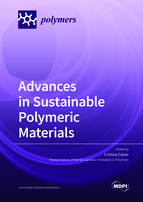Advances in Sustainable Polymeric Materials
A special issue of Polymers (ISSN 2073-4360). This special issue belongs to the section "Circular and Green Polymer Science".
Deadline for manuscript submissions: closed (31 August 2022) | Viewed by 115996
Special Issue Editor
Interests: waste management; polymeric waste; solid waste processing; ecological recycling technology; bioenergy-biomass; life-cycle assessment; composite materials; materials synthesis and processing; materials characterization; surface and interface science; biotechnology; sustainable technology development; environmental assessment
Special Issues, Collections and Topics in MDPI journals
Special Issue Information
Dear Colleagues,
This Special Issue has a special focus on eco-friendly polymers, polymer composites, hybrid polymeric materials, nanocomposites, and blends and polymeric materials for sustainability.
This Special Issue will consider recent advancements in the research and development in synthesis, characterisation, processing, morphology, structure, properties and applications of advanced polymeric materials. Recent advances in the synthesis of polymeric materials by improving the interfaces (of inorganic/organic nature) using different fillers, coupling agents have shown strong potential to generate materials with better sustainability properties.
Fundamental advances in nanocomposite blends and nanostructured polymeric materials in environmental sustainability applications highlight this Issue.
This Special Issue aims to present original articles, reviews, short communications, research notes, analyses, and case studies on topics relating to advances in sustainable polymer materials.
Dr. Cristina Cazan
Guest Editor
Keywords
- eco-friendly polymers
- sustainable materials
- hybrid polymeric materials
- bio-based polymers
- bioplastics
- renewable resources
- polymer composites
- nanocomposites
- materials synthesis and processing
- materials characterization
- surface and interface science







